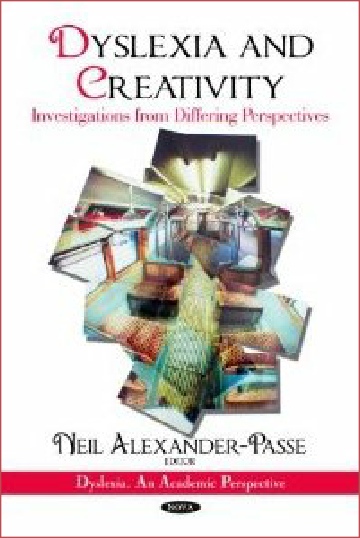

© Dyslexia-Research.com - Dr Neil Alexander-Passe - Contact at: neilpasse@aol.com
Dyslexia-Research.Com - The home of humanistic dyslexia research
An investigation from differing perspectives
‘Dyslexia and Creativity: An Academic Perspective’ is the first in a series to investigate under-researched areas of dyslexia. It has come from a need to investigate a much quoted but little researched and substantiated area of dyslexia, namely positive attributes or talents that have come out of having a learning disability. Whilst traditional understanding of creativity is solely concerned with the arts, wider investigation suggests it includes many other careers, from cooking to sport, business to politics. Thus creativity can be seen is all areas of society.
As dyslexia is traditionally perceived to be a disability affecting reading and writing, many imagine that dyslexics are unable to attain in our word-based society. However many have, and these include world leaders and celebrities, in a range of areas.
Those believed to be dyslexic, include:
Inventors (Leonardo da Vinci, Albert Einstein, Thomas Edison and Michael Faraday),
Artists (Leonardo da Vinci, David Bailey, Pablo Picasso, Andy Warhol, Auguste Rodin),
Actors (Tom Cruise, Robin Williams, Kiera Knightly, Keanu Reeves, Whoppi Goldberg),
Sports people (Mohammed Ali, Sir Steven Redgrave, Magic Johnson, Bruce Jenner, Nolan Ryan, Sir Jackie Stewart),
Political leaders (Winston Churchill, John F Kennedy, George Washington), and
Business people (Sir Richard Branson, Henry Ford, William Hewlett, Charles Schwab, Ted Turner)
So how can they be dyslexic and attain to such high standards? What is that they have, in addition to their difficulties that allow them to reach international success?
One explanation is that dyslexics develop compensation skills as a reaction to their difficulties; another suggests that the dyslexic brain is neurologically different, and a third sees dyslexics as part of the next stage in human evolution, with superior abilities for our modern age.
However research to date has been unable to support the claim that dyslexics are creative or have visual-spatial talents in excess of the normal population. Thus this book aims to shed light on the issue, through three types of perspectives: (1) Academic Perspectives; (2) Personal Perspectives; and (3) Alternative Perspectives.
‘Dyslexia and Creativity: An Academic Perspective’ is the collection of seventeen perspectives, from authors and artists from the US, UK, Sweden and Australia, which aim to enlighten the reader to new academic research, personal views of dyslexic artists, and an investigative interview study challenging dyslexic artists to ‘what makes the dyslexic artist unique’.
‘Dyslexia and Creativity: An Academic Perspective’ is an ideal reference book for researchers, educators, artists, and dyslexics who seek understanding of their creative abilities.
TABLE OF CONTENTS
0 CONTENTS
1 INTRODUCTION
2 AN ACADEMIC PERSPECTIVE
2.1 Creativity and Dyslexia: An investigative study
(Neil Alexander-Passe, UK)
2.2 Dyslexia, reasoning & the importance of visual-spatial processes
(Dr Alison M. Bacon & Professor Simon J. Handley, UK)
2.3 Visual thinking for the digital age
(Richard Chipps, UK)
2.4 Artistic talents and dyslexia: a genuine connection?
(Dr Ulrika Wolff, Sweden)
2.5 Dyslexic Visualizations in Practice: strengths and forgotten frustrations
(Dr Brian O’Keefe, USA)
3 A PERSONAL PERSPECTIVE
3.1 A Dyslexic Artist and her Gallery Environment
(Michelle Molyneux RCA, UK)
3.2 Three Case Studies of Creative Dyslexics
(Neil Alexander-Passe, UK)
3.3 How a unique perception of the world enhances creativity
(Clayton S. Colgin, Australia)
3.4 Dyslexia: Its Impact on My Creative Process
(Bonnie Magoon Haley, USA)
3.5 Dyslexia, Visual Thinking and Lucid Dreaming - An Artist’s Experience
(Mick Bean, UK
3.6 Approaching dyslexia sideways – is it a blessing or a curse?
(Jane Graves, UK)
3.7 How do practicing creative visual artists, who are dyslexic, approach thinking and learning in the process of their work?
(Katherine Hewlett, UK)
4 AN ALTERNATIVE PERSPECTIVE
4.1 The Science of Creativity: Neuroaesthetics
(Dr Beverly Steffert, UK)
4.2 So Near The Discovery: On Not Falling Back Into Old And Preconceived Notions
(Thomas West, USA)


| About the Author |
| Academic CV |
| Teaching CV |
| Research for the book |
| Reviews for the book |
| The Successful Dyslexic Book |
| How can parents support their child with dyslexia? |
| Dyslexia, self-harm and attempted suicide |
| The Lifelong social and emotional effects of Dyslexia |
| Dyslexia and Depression |
| Dyslexia: Dating, Marriage & Parenthood |
| Dyslexia and Creativity |
| Dyslexia and Mental Health-differing perspectives |
| Dyslexia & Mental Health |
| Surving School as a Teenage Dyslexic |